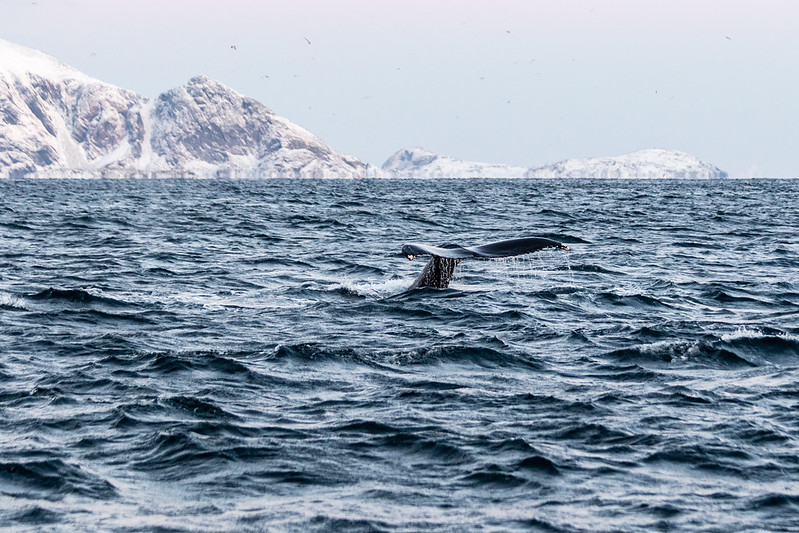Whales are marine mammals that can be found in every ocean habitat on earth, including the world’s coldest Arctic ocean.
The monthly mean temperature at the South Pole in winter hovers around -60°C (-76°F). And along the coast, winter temperatures range between −15 and −20 °C (-5 and −4 °F).
Antarctica is the only continent without any permanent human habitation, and without proper equipment, humans would die there in as little as 20 minutes.
In this post, we’re going to answer a question that often comes up when discussing whales in Arctic habitats. “Are whales cold-blooded?“
NO, whales are NOT cold-blooded. They are warm-blooded and are able to generate their own internal body heat which helps to keep them warm in the freezing polar waters.
Let’s take a closer look…
Are Whales Really Cold Blooded?
Whales are NOT cold-blooded animals. They are warm-blooded, meaning that they can maintain a body temperature that is higher than their environment.
This is essential for living in some of the coldest waters on earth and allows them to stay warm despite the conditions.
Like most marine mammals, whales have a thicker layer of blubber that helps to insulate their bodies from the cold.
The thickness of a whale’s blubber varies on the species, but it can be anywhere from 1 inch to 11 inches thick.
In some species, blubber can account for up to 50% of the marine mammals’ total body weight in some period of their life, often during feeding season when they bulk up.
Why Are Whales Warm-Blooded?
Whales are warm-blooded because they travel to some of the coldest and harshest places on planet earth.
Antarctica offers the richest feeding waters on earth and many whales make their way there every single year to take advantage of this.
The water temperature in Antarctica is below freezing, and without being warm-blooded whales would not be able to travel there.
Humpback whales are one species that will fast for months on end to dedicate all of their energy to the long migration up to the Arctic waters.

Once they get there, they eat enormous amounts of krill to fatten themselves up before making the long trip back down to their breeding grounds.
Being warm-blooded is vital for many whale species to be able to reach Antarctica, as they simply wouldn’t survive if they were cold-blooded.
The water is so cold in the polar region that very few animals can travel there, but it offers the best feeding ground on earth for the eight whale species that can make it there.
Are Any Whale Species Cold Blooded?
ALL whale species are warm-blooded despite being surrounded by many cold-blooded animals such as sharks, fish, and rays.
Whales belong to the family Cetacea along with dolphins and porpoises. All cetaceans have several shared characteristic which includes being warm-blooded.
Below are the shared characteristics cetaceans have:
- Warm-blooded
- Breathing air
- Producing milk to feed their young
- Giving birth
- Having hair (many lose this shortly after birth)
How Else Do Whales Stay Warm?
As well as being warm-blooded, whales also have some other useful adaptations that help them to stay warm in cold conditions.
Counter current heat exchange
Whales have a mechanism known in nature as counter-current heat exchange, which works by transporting fluids in opposite directions to generate heat.
Areas that are not covered in blubber, such as fins, flukes, and flippers benefit from counter-current heat exchange as they are filled with arteries and veins that are close together.
The blood in these areas flows in different directions which allows heat to transfer across membranes.
Heat in the warm blood that leaves the whale’s heart will heat up the cold blood that is on its way back to the heat from its extremities.
Blubber
Blubber is essential in keeping whales and other marine mammals insulated from cold external conditions.
It’s essentially a thick layer of fat located directly under that covers most of the whale’s body.
Whilst blubber is generally thick, the thickness of a whale’s blubber doesn’t fully account for a whale’s ability to stay warm in cold environments.
Lipid and water concentration in a whale’s blubber plays an important role in maintaining the whale’s body heat.
The higher the lipid concentration the warmer the whale will be and vice versa.
This means that whales that have less blubber but a higher lipid concentration may be able to maintain their body heat better than a whale with low lipid levels and more blubber.

Blubber is generally built in the feeding season, with many whale species eating as much as they possibly can in a short period to pack on blubber.
When migrating back down from their feeding grounds, the blubber helps to sustain their long journey and provides a source of energy for their travels.
Final Thoughts
Hopefully, you have a clear answer to your question of are whales cold-blooded and now know more about the reason behind this.
Whales are NOT cold-blooded and instead are warm-blooded marine mammals that are able to maintain their body temperatures despite external conditions.
This allows many species of whales to travel to the coldest regions on earth without freezing to death and allows them to benefit from the abundant feeding waters of Antarctica.
The water is so cold in this region that cold-blooded animals are not able to survive there.
Even most whales can only withstand the freezing arctic conditions for a short amount of time, and ultimately have to travel back to warmer waters at some point.
Thanks for taking the time to read this post and learn more about whales.
Catch you in the next one!

Hi, I’m George – the founder of MarinePatch. I created this blog as marine wildlife has been my passion for many years. I’ve spent over a decade in the marine wildlife industry and spent years out in the field conducting research. In today’s modern world, an online blog is the best place for me to share my findings and reach as many people as possible to help educate and inspire others. Enjoy your time here and you’re welcome back anytime!

